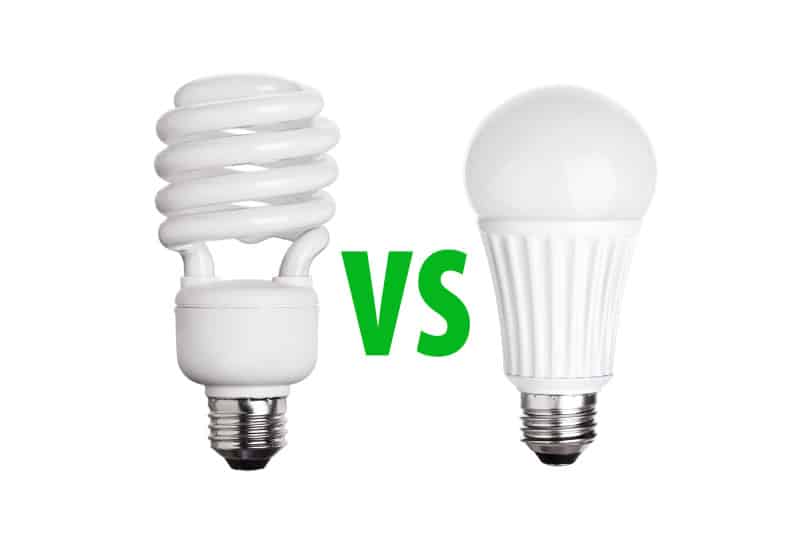Are you looking for energy-efficient lighting options for your home, office or anything else and not sure which type of bulb is going to be best suited to your needs?
You may have come across two popular choices: Compact Fluorescent Lights (CFLs) and Light Emitting Diodes (LEDs).
Both of these options offer significant energy savings compared to traditional incandescent bulbs, but which one is better for your specific needs?
I’m going to do an in-depth comparison of CFLs and LEDs in various settings to help you make an informed decision.
By the end of this article, you should have a better understanding of which energy-saving light is the right choice for your particular setting.
CFL vs LED: Which Is Better for Indoor Lighting?
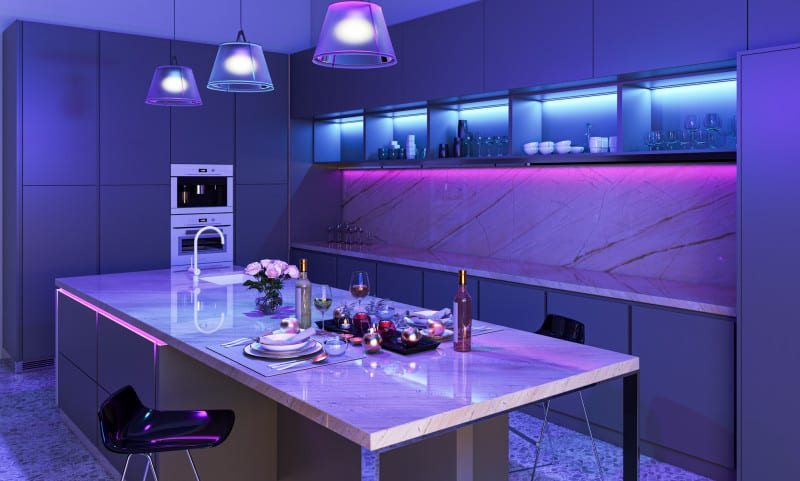
If you want to save on your energy bill and have better indoor lighting, you should switch to LED lights.
LED lights use up to 75% less energy than CFLs, which means you’ll see a significant reduction in your electricity bill.
LED lights come in a variety of color temperatures, ranging from warm white to cool white, allowing you to choose the perfect lighting for your space.
LED lights also have better dimming capabilities than CFLs, so you can easily adjust the brightness of your lights to suit your needs.
While LED lights may have a higher initial cost than CFLs, their longer lifespan makes them a more cost-effective option in the long run.
They have a lower environmental impact than CFLs because they don’t contain mercury and are fully recyclable.
CFL vs LED: Which Is Better for Office Lighting?

You’ll appreciate the difference in brightness and efficiency between the two options when choosing the best lighting for your office.
LED lights are more cost-effective compared to CFLs in the long run, since they consume less energy and last much longer.
CFLs, on the other hand, are known for their negative environmental impact due to the presence of mercury in their bulbs.
In terms of color temperature, LED lights provide a brighter and more accurate color spectrum compared to CFLs so consider how much natural light your office gets before deciding which to go for.
CFL vs LED: Which Is Better for Retail Lighting?

As a savvy retailer, it’s important to consider which lighting option will provide the best ROI for your store.
When it comes to retail design, lighting is critical for creating an inviting atmosphere that encourages shoppers to stay longer and make purchases.
LED lights have become increasingly popular in retail spaces due to their energy savings and ability to provide a more consistent light distribution.
LED lights typically have a higher color rendering index (CRI) than CFL lights, which means they can display colors more accurately and make products appear more attractive to customers.
However, it’s important to ensure that the LED fixtures are compatible with your store’s existing lighting fixtures to avoid any compatibility issues.
CFL vs LED: Which Is Better for Museums?

When it comes to museum lighting, choosing between CFL and LED lights can be a tough decision.
LED lights are known for their energy efficiency, which can save museums money in the long run.
However, CFL bulbs are typically less expensive upfront and have a warm glow that many people find appealing.
One important factor to consider is color accuracy.
Museums need lighting that accurately showcases the colors of their artifacts. LED lights are typically better at color accuracy than CFL bulbs, as they have a higher color rendering index (CRI).
This means that colors under LED lighting appear more vibrant and true to life. However, CFL bulbs have come a long way in recent years and can also offer good color accuracy.
Another factor to consider is energy consumption.
Museums typically have long hours of operation and high electricity bills. LED lights use less energy than CFL bulbs, making them a more cost-effective option in the long run.
However, CFL bulbs can be a good option for smaller museums with lower lighting needs, as they are typically less expensive upfront.
Maintenance costs should also be taken into consideration, as LED lights have a longer lifespan and require less frequent replacement.
Light distribution is important to consider, as museums need lighting that is evenly distributed and doesn’t cause glare or shadows.
Both CFL and LED lights can be good options for museums, and the decision ultimately comes down to factors such as color accuracy, energy consumption, and maintenance costs.
CFL vs LED: Which Is Better for Art Studios?

Don’t miss out on the best lighting option for your art studio, whether you prefer a warm and cozy glow or vibrant and true-to-life colors.
When it comes to CFL vs LED lights, both have their own advantages and disadvantages.
Let’s start with light temperature and color rendering. CFL lights have a warm and cozy glow, while LED lights can provide a more vibrant and true-to-life color.
This makes LED lights a better choice for art studios, where accurate color representation is crucial.
Another important aspect to consider is the flicker effect and cost comparison. CFL lights tend to flicker, which can cause eye strain and headaches, making LED lights a better choice for prolonged use in an art studio.
LED lights have a longer lifespan and consume less energy, resulting in a lower overall cost in the long run.
And, of course, environmental impact is a crucial factor to consider.
LED lights are more eco-friendly than CFL lights, as they do not contain mercury and can be easily recycled.
The choice between CFL and LED lights for your art studio depends on your personal preferences and needs, but considering all of the factors mentioned above, LED lights may be the better option.
CFL vs LED: Which Is Better for Photography?

Choosing the perfect lighting for photography can be challenging, but understanding the differences between CFL and LED can make all the difference in capturing the perfect shot.
There are several photography lighting considerations to keep in mind when choosing between CFL and LED lights.
Here’s what to consider:
- Color temperature suitability: LED lights tend to have more accurate color rendering than CFL lights, making them a better choice for portrait photography and product photography where color accuracy is crucial.
- Light output comparison: CFL lights are generally brighter than LED lights, making them a better choice for large studio spaces or outdoor shoots where high output is required.
- Flicker-free lighting: Both CFL and LED lights can produce flicker, but LED lights are typically less prone to flicker, making them a better choice for video shoots.
In addition to these considerations, it’s important to think about compatibility with light modifiers.
LED lights can be more difficult to modify than CFL lights, which can limit your ability to shape and control the light.
CFL vs LED: Which Is Better for Video Recording?

When it comes to video recording, you need to consider factors such as lighting temperature, color accuracy, flicker rate, dimming capability, and glare reduction.
Both CFL and LED lights have their pros and cons in these areas, so it’s important to know what your priorities are before making a decision.
CFLs tend to have a warmer, yellower light, while LEDs can produce a cooler, bluer light.
This means that if you’re looking for a warmer, more natural light for your video recording, CFLs may be the better choice.
However, if you need more accurate color representation, LEDs are generally more reliable.
LEDs have a higher flicker rate than CFLs, which means they’re less likely to cause issues with your video footage.
When it comes to dimming capability and glare reduction, LEDs tend to perform better than CFLs.
CFL vs LED: Which Is Better for Reading?

If you want to read without straining your eyes, you’ll want to know which type of light is better for your reading needs.
Both CFL and LED lights are energy-efficient and long-lasting, but when it comes to reading comfort, LED lights are the clear winner.
LED lights provide bright and clear illumination, which is essential for reading.
They also offer better color accuracy, which helps to reduce eye strain and enhance reading comfort.
LED lights also come with the added benefit of brightness control.
You can easily adjust the brightness levels of LED lights to suit your reading needs, whether you’re reading in daylight or at night.
This feature not only enhances reading comfort, but it also helps to minimize eye fatigue and strain.
LED lights provide excellent contrast enhancement, which helps to distinguish between text and background, making it easier to read for extended periods of time.
CFL vs LED: Which Is Better for Makeup Application?

You absolutely need to have the best lighting for your makeup application, and nothing beats the clarity and precision of LED lights.
When it comes to lighting temperature, LED lights come in a range of options, from warm to cool, allowing you to choose the perfect temperature for your makeup needs.
LED lights have a high color rendering index (CRI), meaning that they accurately show colors as they would appear in natural daylight, making it easier to match your makeup to your skin tone.
They also excel in glare reduction and shadow elimination.
Unlike CFL lights, which can create harsh shadows and glare, LED lights provide a more even and consistent light source, allowing you to see every detail of your face without any harsh shadows.
LEDs often come with brightness control options, allowing you to adjust the light intensity to your preference, making it easier to apply makeup in different lighting conditions.
When it comes to makeup application, LED lights provide the ideal lighting solution, offering excellent lighting temperature options, high CRI, glare reduction, shadow elimination, and brightness control.
CFL vs LED: Which Is Better for Medical Facilities?

Medical facilities require lighting that’s reliable and consistent to ensure accurate diagnoses and treatments.
When it comes to choosing between CFL and LED lights, there are several factors to consider.
One of the most important factors is energy consumption. LED lights are known for their energy efficiency, consuming up to 75% less energy than CFL lights.
This lower energy consumption not only results in cost savings but also reduces the environmental impact of the facility.
Another important factor to consider is the health benefits of the lighting.
LED lights emit light in a more natural way, closer to daylight, which can have positive effects on patients and staff.
LED lights don’t contain harmful materials like mercury, which is found in CFL lights and can be hazardous to health if not disposed of properly.
CFL vs LED: Which Is Better for Warehouses?
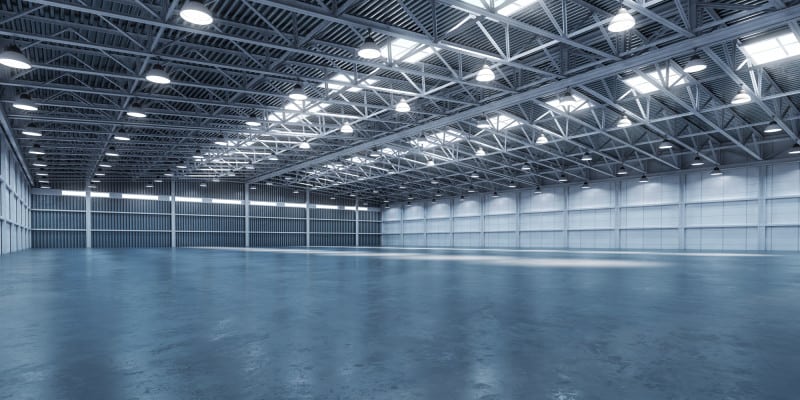
When it comes to lighting warehouses, choosing the right type of lighting is crucial for optimizing productivity and safety.
LED lights have become a popular choice for warehouse lighting due to their energy-saving benefits.
Here are some other factors to consider when choosing between CFL and LED lighting for your warehouse:
- Energy Consumption: LED lights use significantly less energy than CFL lights. This means lower electricity bills and a reduced carbon footprint.
- Maintenance Costs: LED lights have a longer lifespan than CFL lights, which means fewer replacements and lower maintenance costs in the long term.
- Environmental Impact: LED lights are more environmentally friendly than CFL lights. They do not contain toxic materials such as mercury, which is found in CFL lights.
In addition to energy consumption, maintenance costs, and environmental impact, it’s important to consider color temperature and brightness levels when choosing the right lighting for your warehouse.
LED lights offer a wider range of color temperatures, which can help create a more comfortable working environment.
They also provide brighter and more consistent lighting, which can improve safety and productivity in a warehouse setting.
CFL vs LED: Which Is Better for Parking Lots?
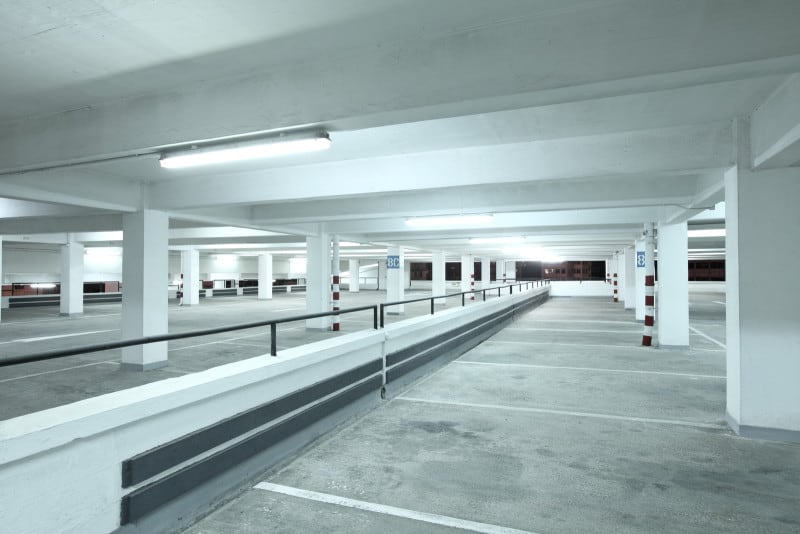
Looking to upgrade your parking lot lighting?
When it comes to choosing between CFL and LED lights, there are several factors to consider.
One of the most important factors is the cost analysis. While LED lights have a higher upfront cost, they offer a much longer lifespan and lower maintenance requirements compared to CFL lights.
This means that over the long run, LED lights can result in significant cost savings.
LED lights are considered to be more environmentally friendly than CFL lights due to their lower energy consumption and longer lifespan and they don’t contain mercury, which is a harmful substance often found in CFL lights.
When it comes to light output and color temperature, LED lights provide a brighter and more consistent light output, as well as a wider range of color temperatures to choose from.
If you want to optimize energy efficiency and cost savings for your parking lot lighting, consider upgrading to LED lights instead of CFL’s if at all possible.
CFL vs LED: Which Is Better for Streetlights?
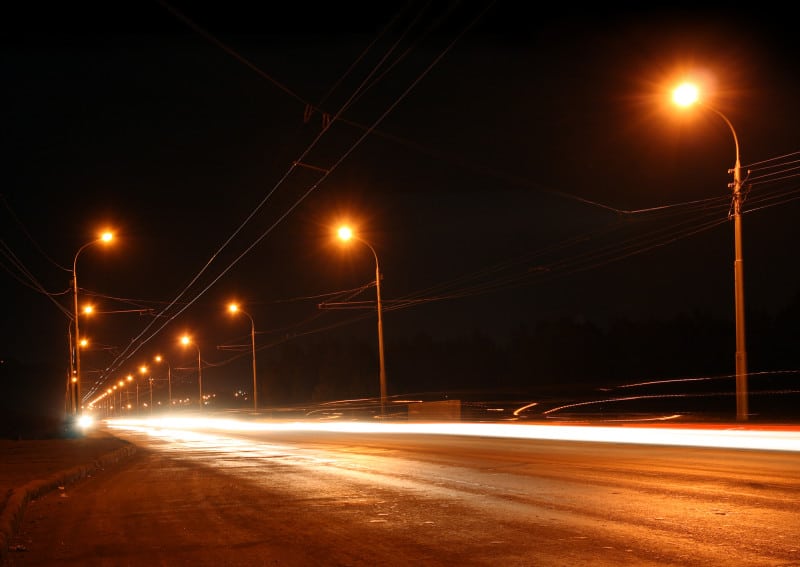
You might be wondering which type of lighting is best for your streetlights – whether it’s CFL or LED.
To make an informed decision, it’s important to consider various factors.
Here’s a cost effectiveness comparison, environmental impact analysis, maintenance requirements analysis, light output analysis, and longevity comparison to help you decide:
- Cost effectiveness comparison: CFLs are generally cheaper to purchase, but LEDs have a longer lifespan and lower energy usage, which means they can save you money in the long run.
- Environmental impact analysis: CFLs contain small amounts of mercury, which can be harmful if not disposed of properly. LEDs do not contain mercury and are generally considered more environmentally friendly.
- Maintenance requirements analysis: CFLs have a shorter lifespan and require more frequent replacement, which can be costly and time-consuming. LEDs have a longer lifespan and require less maintenance overall.
When it comes to streetlights, LED lights are generally the better choice.
They have a higher initial cost but offer long-term savings due to their energy efficiency and longevity. They are considered more environmentally friendly and require less maintenance over time.
However, it’s important to consider all factors before making a decision, as each situation is unique and may have different requirements.
CFL vs LED: Which Is Better for Aquariums?
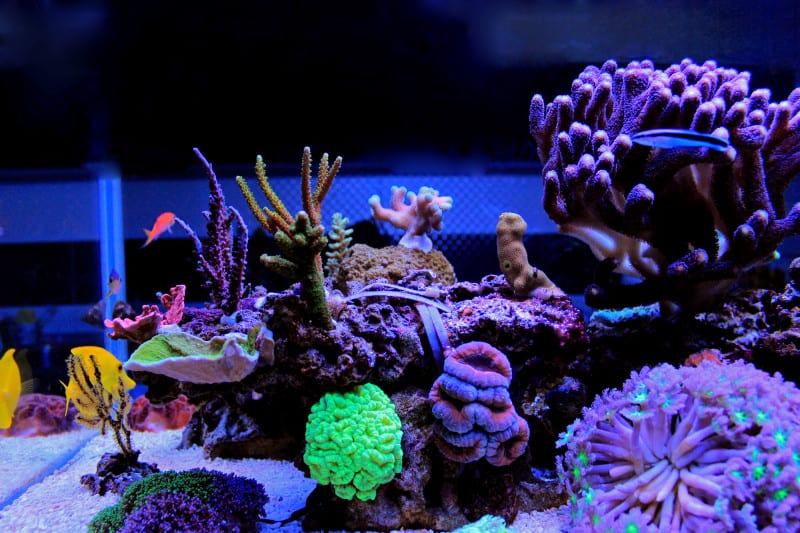
Opting for LEDs over CFLs in aquariums is a no-brainer due to their longer lifespan and eco-friendliness.
CFLs have a lifespan of about 8,000 hours, whereas LEDs can last up to 50,000 hours, making them a much better long-term investment.
CFLs contain small amounts of mercury, which can be harmful to the environment if not disposed of properly.
On the other hand, LEDs are free of toxic materials and are 100% recyclable.
When choosing between CFL and LED for your aquarium, there are several factors to consider. The type of plants and fish in your aquarium will determine the lighting requirements.
For example, some plants require higher levels of light, while others thrive in low light conditions.
LED lights can be adjusted to different color temperatures, which can enhance the appearance of fish and plants in the aquarium.
While CFLs may be cheaper initially, LEDs are the better option for long-term use and environmentally conscious aquarists.
CFL vs LED: Which Is Better for Reptile Habitats?
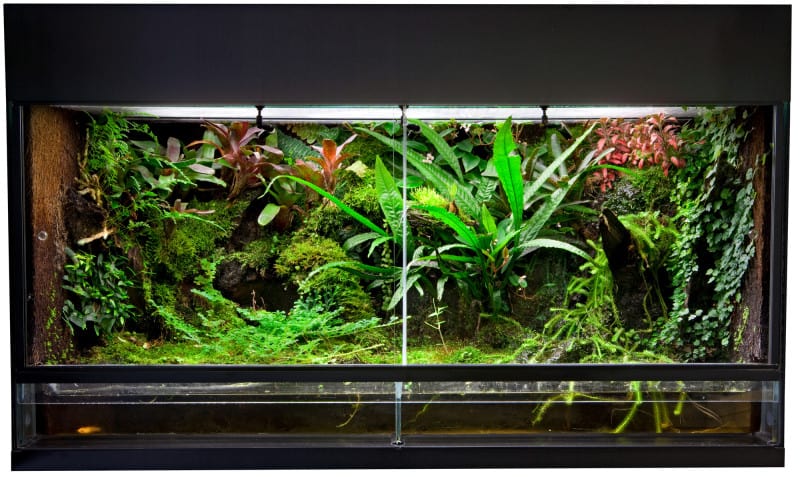
If you’re considering lighting options for your reptile habitat, it’s important to compare the benefits of each type of bulb.
CFL and LED lights are both energy-saving options, but they have different advantages and disadvantages when it comes to reptile behavior, UVB requirements, heat emission, color rendering, and energy consumption.
CFL bulbs are great for providing a bright and consistent source of UVB light, which is essential for reptile health.
They also emit a lot of heat, which can be beneficial for certain species that require higher temperatures.
However, CFL bulbs have poor color rendering compared to LED bulbs, which can affect the appearance of your reptile’s skin and habitat.
CFL bulbs consume more energy than LED bulbs, which can add up over time.
LED bulbs, on the other hand, are great for providing a natural-looking environment for your reptiles, as they have better color rendering and emit less heat.
They also consume less energy, which can save you money in the long run.
However, they may not provide as much UVB light as CFL bulbs, which can be an issue for species that require a high level of UVB exposure.
CFL vs LED: Which Is Better for Plant Growth?
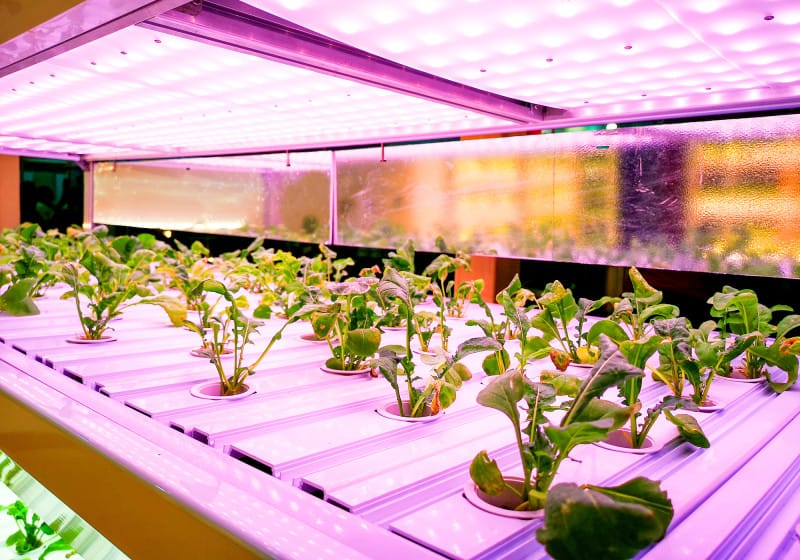
If you’re looking to grow plants in your home or greenhouse, it’s crucial to choose the right type of lighting.
To begin with, when comparing CFL and LED lights for plants, spectral output analysis is crucial.
This analysis is used to measure the wavelengths of light emitted by each type of bulb, and how those wavelengths affect plant growth.
Research has shown that LED lights have a more balanced spectrum of light, which is better suited for plant photosynthesis.
Light intensity measurements also play a crucial role in plant growth.
LED lights are known to emit more intense light than CFLs, which is important for plants that require high levels of light to grow.
In addition to plant growth comparison, cost effectiveness analysis and environmental impact assessment are also important factors to consider.
LED lights are generally more expensive than CFLs, but they are more energy-efficient and have a longer lifespan, making them a better long-term investment.
LEDs also have a lower environmental impact, as they produce less heat and contain fewer harmful materials than CFLs.
CFL vs LED: Which Is Better for Poultry Farming?

When considering the lighting for poultry farming, it’s important to choose the type of lighting that will provide the most benefits for the health and productivity of the animals.
When it comes to comparing CFL and LED lights for poultry farming, there are pros and cons to both.
Here are some factors to consider:
- Pros and Cons: CFL lights are cheaper upfront, but they have a shorter lifespan and consume more energy than LED lights. LED lights, on the other hand, are more expensive upfront but have a longer lifespan and consume less energy.
- Installation Process: Both types of lights are easy to install, but LED lights require a higher initial investment due to the need for specialized fixtures and wiring.
- Maintenance Requirements: CFL lights require more maintenance as they need to be changed more frequently, while LED lights have a longer lifespan and require less maintenance.
- Environmental Impact: LED lights are more environmentally friendly as they consume less energy and have a longer lifespan, resulting in less waste.
Another important factor to consider is the cost comparison between the two types of lights.
While LED lights have a higher upfront cost, they save more money in the long run due to their energy efficiency and longer lifespan.
CFL vs LED: Which Is Better for Dairy Farming?
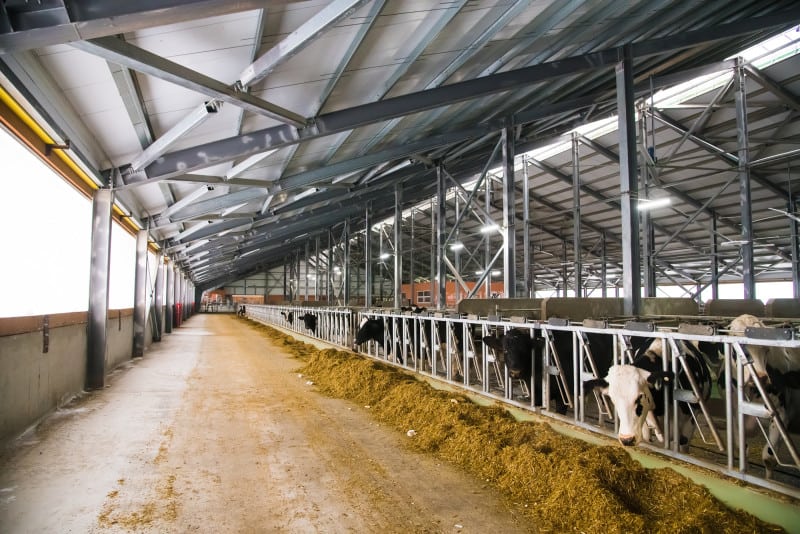
Choosing the right lighting for dairy farming is crucial for maintaining the health and productivity of cows.
When it comes to energy-saving lights, there are two popular options: CFL and LED.
Both types of lights offer advantages and disadvantages, so it’s important to consider several factors before making a decision.
One key factor is dairy productivity. Studies have shown that LED lighting can improve milk production in dairy cows.
This is because LED lights provide a more consistent level of lighting intensity, which helps regulate the cows’ circadian rhythm and melatonin production.
LED lights have a higher color rendering index, which means they provide more natural-looking light that can help reduce stress in cows.
However, LED lights also emit less heat than CFL lights, which can be a disadvantage in colder climates.
CFL vs LED: Which Is Better for Reducing Electricity Bills?
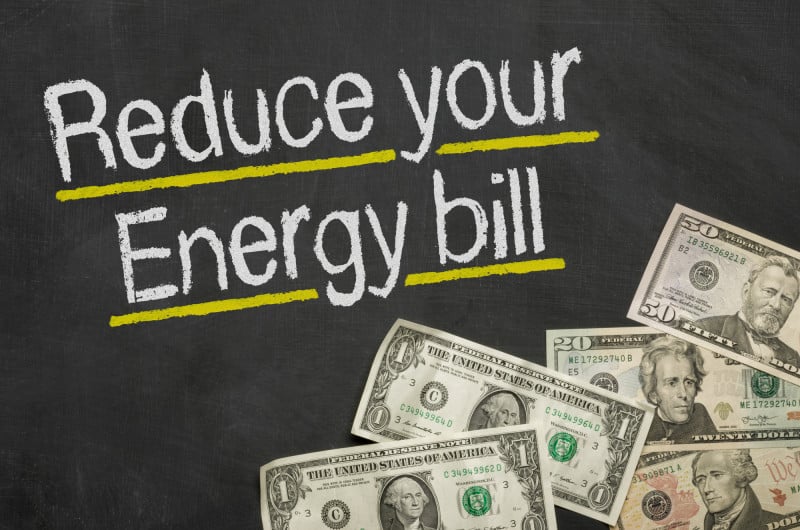
If you want to lower your electricity bills, you should consider which type of light bulb is more cost-effective in the long run.
Here’s a comparison between CFL and LED bulbs to help you make an informed decision:
- Cost comparison: LED bulbs are more expensive than CFL bulbs at the time of purchase, but they last longer and consume less energy, making them more cost-effective in the long run.
- Environmental impact: CFL bulbs contain small amounts of mercury, which can be harmful to the environment if not disposed of properly. LED bulbs don’t contain any hazardous materials and are more eco-friendly.
- Lifespan analysis: LED bulbs have a longer lifespan than CFL bulbs, lasting up to 25,000 hours compared to 10,000 hours for CFL bulbs. This means that LED bulbs need to be replaced less frequently, resulting in additional cost savings.
- Color temperature preference: LED bulbs offer a wider range of color temperatures, allowing you to choose the perfect ambiance for your space. CFL bulbs typically have a warmer color temperature, which may not be suitable for all areas.
- Brightness level comparison: LED bulbs are more efficient in providing bright and consistent light compared to CFL bulbs, which can take some time to reach full brightness. LED bulbs also have better dimming capabilities for more control over your lighting.
LED bulbs are the better option for reducing electricity bills due to their longer lifespan, lower energy consumption, and eco-friendliness.
While they may be more expensive upfront, the cost savings in the long run make them a smart investment.
CFL vs LED: Which Is More Energy-Efficient?
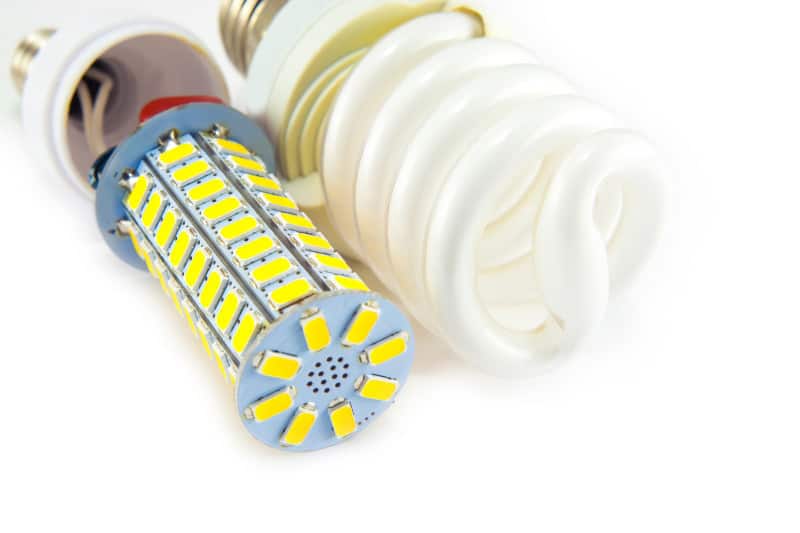
Looking for the most efficient lighting option? Let’s compare CFL and LED bulbs in terms of energy efficiency.
When it comes to energy efficiency, LED bulbs are the clear winner.
LED bulbs use significantly less energy than CFLs and have a longer lifespan, making them a more cost-effective option in the long run.
LED bulbs have a higher light output measurement, meaning they produce brighter light than CFLs while using less energy.
When conducting an environmental impact assessment, LED bulbs also come out on top as they contain no harmful chemicals and are more easily recyclable than CFLs.
If you’re looking for an energy-efficient and environmentally-friendly option, LED bulbs are the way to go.
CFL vs LED: Which Saves More Money In The Long Run?
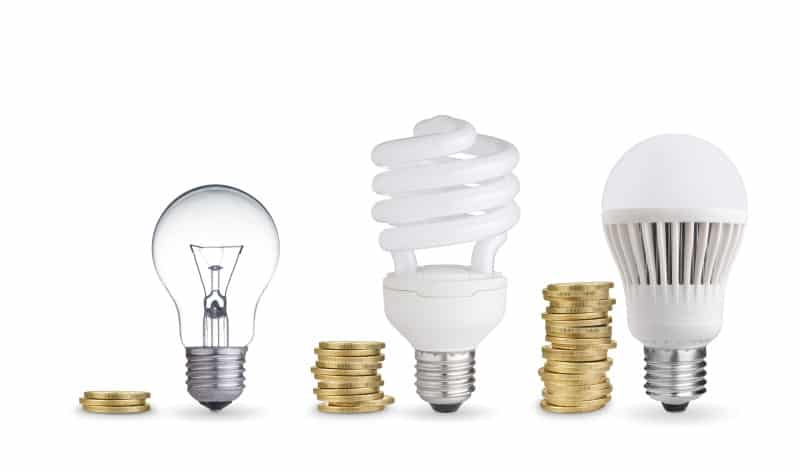
When it comes to long-term cost savings, LED lighting is the clear winner over CFLs.
While CFLs have a lower initial cost, the lifespan comparison between the two shows that LED lights last significantly longer.
This means that while you may have to replace CFLs multiple times over the lifespan of one LED light, you will only need to purchase and install an LED light once.
So, while the initial cost of LED lights may be higher, the long-term savings and benefits make them a worthwhile investment.
CFL vs LED: Which Is More Durable?
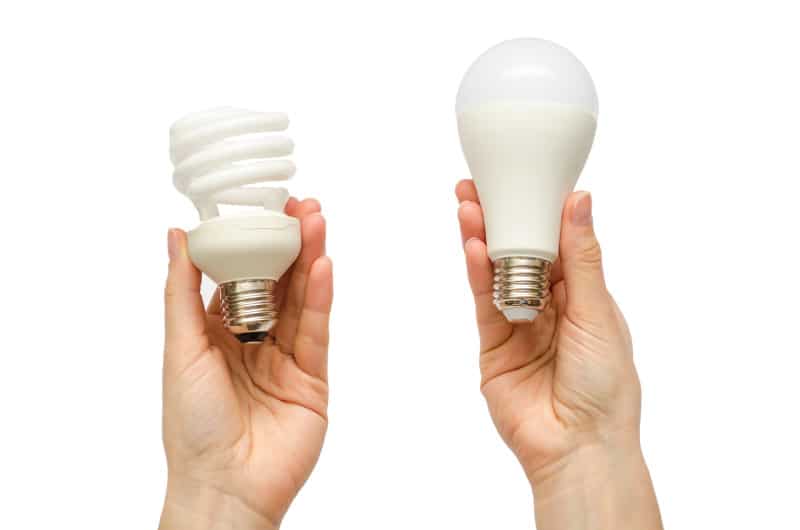
You may be surprised to learn that when it comes to durability, LED lights outperform CFLs in almost every way.
A CFL bulb typically lasts around 10,000 hours, while an LED bulb can last up to 50,000 hours or even more.
This means that LED lights can last up to five times longer than CFLs, which makes them a much more durable option in the long run.
In addition to their longer lifespan, LED lights are also more impact-resistant than CFLs.
They’re made with solid-state technology, which means they’re less likely to break or shatter if they’re dropped or bumped.
This makes them a safer option, especially in homes with children or pets.
CFL vs LED: Which Emits Less Heat?
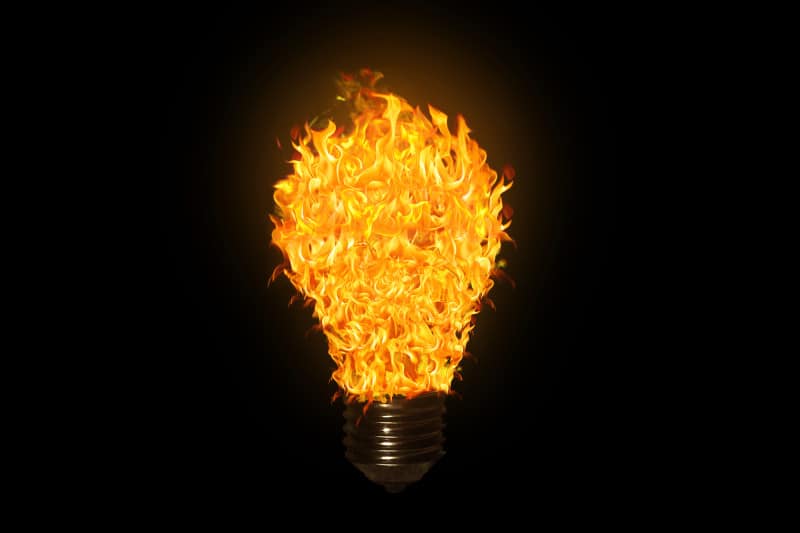
Oddly enough, LED bulbs emit significantly less heat than CFLs.
This is due to the fact that LED bulbs are more efficient at converting electricity into light, whereas CFL bulbs generate more heat as a byproduct of their operation.
This lower heat emission makes LED bulbs safer to use, especially in areas with poor ventilation or in close proximity to flammable materials.
The reduced heat emission of LED bulbs also has a significant impact on energy consumption and cost effectiveness.
Because LED bulbs require less energy to produce the same amount of light as CFLs, they can save you money on your electricity bill in the long run.
The reduced heat emission means that your cooling system won’t have to work as hard to maintain a comfortable temperature in your home or office, further reducing your energy costs and environmental impact.
CFL vs LED: Which Is Safer To Use?

Due to their lower heat emission, LED bulbs are a safer choice for households and businesses, especially in areas with poor ventilation or flammable materials nearby.
CFL bulbs, on the other hand, emit more heat and can pose a safety hazard if not used properly.
CFL bulbs also contain small amounts of mercury, which can be harmful to human health and the environment if not disposed of properly.
While both CFL and LED bulbs are energy-efficient options, LED bulbs are the safer and more environmentally-friendly choice.
CFL vs LED: Which Provides Better Lighting Quality?
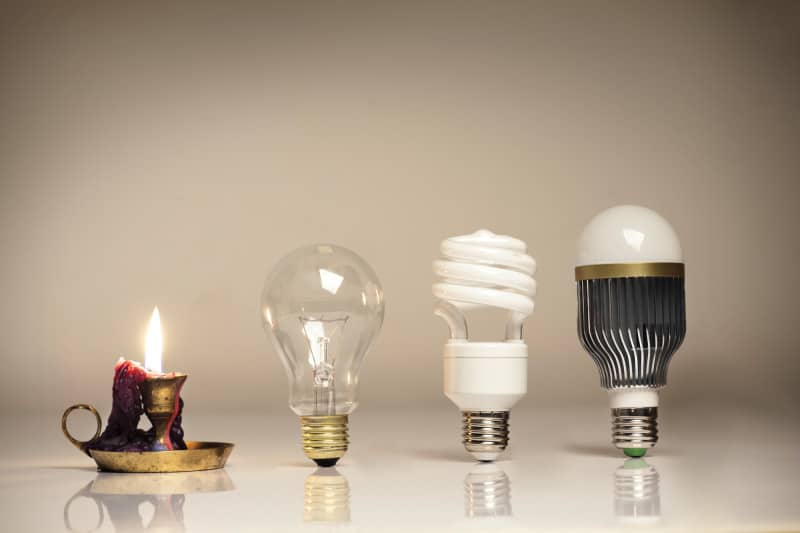
Ironically, the type of bulb that provides better lighting quality is often the one that people don’t associate with energy efficiency.
When it comes to CFL vs LED, the latter is considered to provide better lighting quality.
Here’s a comparison between the two types of bulbs in terms of color temperature, dimming capabilities, environmental impact, maintenance cost, and energy consumption:
- Color Temperature Comparison: LED bulbs have a wider range of color temperatures, from warm to cool, whereas CFL bulbs tend to have a cooler light.
- Dimming Capabilities Comparison: LED bulbs are generally better at dimming smoothly, whereas CFL bulbs may flicker or take time to warm up.
- Environmental Impact Comparison: LED bulbs contain no hazardous materials, are more energy efficient, and have a longer lifespan, making them the more environmentally friendly option.
- Maintenance Cost Comparison: LED bulbs last longer than CFL bulbs, meaning that they need to be replaced less frequently, which ultimately results in lower maintenance costs.
LED bulbs provide better lighting quality than CFL bulbs.
They have a wider range of color temperatures, better dimming capabilities, are more environmentally friendly, and have lower maintenance costs.
Conclusion
Both CFL and LED lights have their own advantages and disadvantages depending on the intended use.
However, in terms of energy efficiency, LED lights are the clear winner as they use up to 80% less energy than CFLs.
LED lights have a longer lifespan, emit less heat, and provide better lighting quality. It’s important to note that while CFLs may be cheaper upfront, the long-term savings and benefits of using LED lights make them a better investment.
So, whether you’re looking for indoor lighting, office lighting, retail lighting, or even museum and art studio lighting, LED lights are the safer, more durable, and better quality option.
Don’t be left in the dark—switch to LED lights and save both energy and money.

